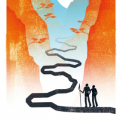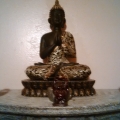The Basic Points Unifying the Theravāda and the Mahāyāna
 Shoshin1
Sentient BeingOceania Veteran
Shoshin1
Sentient BeingOceania Veteran
Just thought some may find this of interest...
The Basic Points Unifying the Theravada and the Mahayana
The Basic Points Unifying the Theravāda and the Mahāyāna is an important Buddhist ecumenical statement created in 1967 during the First Congress of the World Buddhist Sangha Council (WBSC), where its founder Secretary-General, the late Venerable Pandita Pimbure Sorata Thera, requested the Ven. Walpola Rahula to present a concise formula for the unification of all the different Buddhist traditions. This text was then unanimously approved by the Council...
The Buddha is our only Master (teacher and guide)
1)We take refuge in the Buddha, the Dharma and the Saṅgha (the Three Jewels)
2)We do not believe that this world is created and ruled by a God.
3)We consider that the purpose of life is to develop compassion for all living beings without discrimination and to work for their good, happiness, and peace; and to develop wisdom (prajñā) leading to the realization of Ultimate Truth
4)We accept the Four Noble Truths, namely duḥkha, the arising of duḥkha, the cessation of duḥkha, and the path leading to the cessation of duḥkha; and the law of cause and effect (pratītyasamutpāda)
5)All conditioned things (saṃskāra) are impermanent (anitya) and duḥkha, and that all conditioned and unconditioned things (dharma) are without self (anātma) (see trilaksana).
6)We accept the thirty-seven qualities conducive to enlightenment (bodhipakṣadharma) as different aspects of the Path taught by the Buddha leading to Enlightenment.
7)There are three ways of attaining bodhi or Enlightenment: namely as a disciple (śrāvaka), as a pratyekabuddha and as a samyaksambuddha (perfectly and fully enlightened Buddha). We accept it as the highest, noblest, and most heroic to follow the career of a Bodhisattva and to become a samyaksambuddha in order to save others.
8)We admit that in different countries there are differences regarding Buddhist beliefs and practices. These external forms and expressions should not be confused with the essential teachings of the Buddha.
Ven. Walpola Sri Rahula in 1981 [2] offered an alternative to the Nine-point formula above restating it as follows:
Whatever our sects, denominations or systems, as Buddhists we all accept the Buddha as our Master who gave us the Teaching.
1)We all take refuge in the Triple Jewel: the Buddha, our Teacher; the Dhamma, his teaching; and the Sangha, the Community of holy ones. In other words, we take refuge in the Teacher, the Teaching and the Taught.
2)Whether Theravada or Mahayana, we do not believe that this world is created and ruled by a god at his will.
3)Following the example of the Buddha, our Teacher, who is embodiment of Great Compassion and Great Wisdom, we consider that the purpose of life is to develop compassion for all living beings without discrimination and to work for their good, happiness and peace; and to develop wisdom leading to the realization of Ultimate Truth.
4)We accept the Four Noble Truths taught by the Buddha, namely, Dukkha, the fact that our existence in this world is in predicament, is impermanent, imperfect, unsatisfactory, full of conflict; Samudaya, the fact that this state of affairs is due to our egoistic selfishness based on the false idea of self; Nirodha, the fact that there is definitely the possibility of deliverance, liberation, freedom from this predicament by the total eradication of the egoistic selfishness; and Magga, the fact that this liberation can be achieved through the Middle Path which is eight- fold, leading to the perfection of ethical conduct (sila), mental discipline (samadhi) and wisdom (pañña).
We accept the universal law of cause and effect taught in the Paticcasamuppada (Skt. pratityasamutpada; Conditioned Genesis or Dependent Origination), and accordingly we accept that everything is relative, interdependent and interrelated and nothing is absolute, permanent and everlasting in this universe.
5)We understand, according to the teaching of the Buddha, that all conditioned things (samkhara) are impermanent (anicca) and imperfect and unsatisfactory (dukkha), and all conditioned and unconditioned things (dhamma) are without self (anatta).
6)We accept the Thirty-seven Qualities conducive to Enlightenment (bodhipakkhiyadhamma) as different aspects of the Path taught by the Buddha leading to Enlightenment, namely,
Four Forms of Presence of Mindfulness (Pali: satipatthana; Skt. smrtyupasthana);
Four Right Efforts (Pali. sammappadhana; Skt. samyakpradhana);
Four Bases of Supernatural Powers (Pali. iddhipada; Skt. rddhipada);
Five Faculties (indriya: Pali. saddha, viriya, sati, samadhi, panna; Skt. sraddha, virya, smrti, samadhi, prajna);
Five Powers (bala, same five qualities as above);
Seven Factors of Enlightenment (Pali. bojjhanga; Skt. bobhyanga);
Eight-fold Noble Path (Pali. ariyamagga; Skt. aryamarga).
7)There are three ways of attaining Bodhi or Enlightenment according to the ability and capacity of each individual: namely, as a Sravaka (disciple), as a Pratyekabuddha (Individual Buddha) and as a Samyaksambuddha (Perfectly and Fully Enlightened Buddha). We accept if as the highest, noblest and most heroic to follow the career of a Boddhisattva and to become a Samyksambuddha in order to save others. But these three states are on the same Path, not on different paths. In fact, the Sandhinirmocana-sutra, a well-known important Mahayana sutra, clearly and emphatically says that those who follow the line of Sravaka-yana (Vehicle of Disciples) or the line of Pratyekabuddha-yana (Vehicle of Individual Buddhas) or the line of Tathagatas (Mahayana) attain the supreme Nirvana by the same Path, and that for all of them there is only one Path of Purification (visuddhi-marga) and only one Purification (visuddhi) and no second one, and that they are not different paths and different purifications, and that Sravakayana and Mahayana constitute One Vehicle One Yana (eka-yana) and not distinct and different vehicles or yanas.
8)We admit that in different countries there are differences with regard to the ways of life of Buddhist monks, popular Buddhist beliefs and practices, rites and rituals, ceremonies, customs and habits. These external forms and expressions should not be confused with the essential teachings of the Buddha.
-One Vehicle for Peace by Ven. Walpola Sri Rahula, (December 1–7, 1981)
We are all everyday Buddhists...well I like to think that this is the case...🙏🙏🙏









Comments
It is good to look at the things that unify the traditions, rather than the places where they differ.
Ah ha!
Unifying the traditions. Could be a plan (not for cunts cults though)
Must work on left right speech.
Great post and reminder @Shoshin. Venerable Walpola Sri Rahula Hoop was my first introduction to Dharma, when I was old enough to read. It was the only book worth reading that my uncle owned …
Sadly I am not part of the unity, I believe in a creator God, who does not even rule Herself or even exist. A non existent God … now that is what I do believe is omnipotent, impediment unruly and irrelevant. I like Her already …
I’m working at creating a way to unify Thai forest Buddhism and Chinese Pure Land. But they seem to be two ends of the spectrum
One has us focus on the present moment while one is more geared to what happens after death.
I guess in some ways they’re the perfect mix right?
Thai Forest Pure Land hehe 😜
Maybe you need a bit of pan-Buddhist movement, a series of ideas where your two Buddhisms come together @bunks.
well, at least (unlike Woody Allen) you won't be worried about dying, or being there when it happens!
I will hastily add I wish you a long and happy life, @Bunks ...
I must admit I always found religions which focus on death and give you promises about what happens after death too wishy-washy… they are completely unverifiable, too far away from ehipassiko and testing the teachings.
I mean, Islam promises you virgins and rivers of wine in the afterlife. I mean, don’t they seem like worldly pleasures to you? They couldn’t even be original? And then you have to lay down your life for that?
I agree. If all the religion teaches you is to preparing for death and what comes after it seems crazy. There has to be an element of present moment to it.
Yes, present moment and the path from here on forwards. Otherwise it cannot be tested or experienced, and it becomes entirely too easy for religious con-artists to befuddle you. It’s mankind’s great weakness, wondering about death, but really we should just admit that it is beyond our ken, it is not testable except by those who have had near-death experiences.
Maybe if you look at it just right you will find the Pure Land in the present moment, the only moment.
Who knows?
Haha yeah. I understand. That's a very Theravadic(?) / Western way to look at it.
But that's not what the Pure Land school teaches based on the Sutras spoken by the Buddha.
"Then the Buddha addressed Shariputra, the elder, and said, 'Beyond a hundred thousand kotis of Buddha-lands westwards from here, there is a world named Sukhavati. In that world there is a Buddha, Amita(-ayus) by name, now dwelling and preaching the law. Shariputra, why is that country named Sukhavati? The living beings in that country have no pains, but receive pleasures only. Therefore, it is called Sukhavati." - The Smaller Sukhavativyuha Sutra
That's the Pure Land....
Yes, the Pure Land is very much about what happens after death. Theravada seems to be more about the process of this life, if Ajahn Chah is to be believed at least.
Linji Zen actually but hey... So many ways to arrive.
It sounds nice.
Perhaps one day when the work is done it will serve as a good retirement.
Funny enough @Bunks (and not sure if we already had this conversation or not) the Hamilton Buddhist Church here is run by the Jodo Shinshu Buddhist tradition which is a branch of Pure Land and they graciously allow us to sit there as a branch of MPC (Mindfulness Practice Center in the tradition of Plum Village which itself is like a continuation of Linji Zen). I can go there and the one in Toronto. Once everybody is back to sitting in person it seems I may get a glimpse into Pure Land dharma.